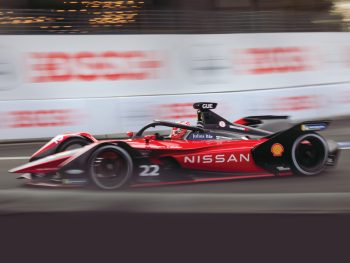Fantasy Fleet: Nissan Formula E Gen 3
Fleet World editor John Challen ponders something a little different from the normal user-chooser selections.

The world’s most efficient race car
Electric cars are the future, right? With the likes of a single-seat race car with 335hp from only a battery pack and a potential top speed of more than 174mph, I say bring it on!
Nissan entered Formula E four years ago, joining a motor racing series that will start its ninth season in the coming months. (It’s actually badged as the 2022/23 Formula E World Championship, but it kicks off in Mexico in mid-January 2023).
Nissan – like many of the other manufacturers involved – decided to jump on the bandwagon to showcase its innovations in electric vehicles. There was also the added benefit of proving to an audience who predominantly favour petrol-based motorsport that racing with batteries and electric motors can be fun. A lot of die-hard F1 fans won’t have any of it, obviously, but for others with a slightly more open mind, it’s quite the spectacle.
These are interesting times for the world of Formula E – Nissan and its counterparts have left the second-generation car behind and are busy preparing for the more powerful third-generation racers. The outgoing Nissan (pictured – its replacement is still under wraps) was already quite a rapid performer (0-62mph was dispatched in 2.8 seconds), but the new car promises to be something else. Lighter and smaller than the outgoing model, the Gen 3 variant will boast a 469hp powertrain at the rear, in addition to a 335hp one at the front. While the sprint time to 62mph hasn’t been declared, it promises to hit a top speed of 200mph.
There are several milestones with the new Nissan racer. To start with, it’s the first Formula car with both front and rear powertrains. In addition, it’s also the first car of its kind that has no hydraulic brakes, thanks to the addition of regeneration via the front powertrain. To clarify, the Gen 3 car will have 40% of its energy produced via regenerative braking during the race.
The cars might not look like traditional Nissans, but the names are familiar. For the 2022/23 season car #22 is the Leaf and #23 is the Ariya. Once again, the Japanese brand is making the link between road and race car and who can blame it?
Such is the success of Nissan’s powertrain in the Formula E racer that it has agreed a deal to supply McLaren (I know, right?) with the technology for the upcoming seasons. McLaren, which acquired the Mercedes EQ team for the 2022-23 season, said Nissan was an “ideal partner” for its debut season in the race series.
Efficiency is a key consideration throughout the car – but also the team. Sustainability rules (important when you’re trying to ‘sell’ a race series that travels – by plane – all over the world) dictate that the maximum team size is 17. And that includes the drivers who, as it happens are also new for next season. Norman Nato and Sacha Fenestraz are the two to watch who will be behind the wheels of the ‘other’ Ariya and Leaf models…
Price: POA! If you have to ask…
Powertrains: 335hp (front)and 469hp (rear)
Max Torque: 900Nm
Tyres: Bespoke Michelin Pilot Sports
Claim to fame: The world’s most efficient race car
Likelihood of making it onto the fleet? 1/10












